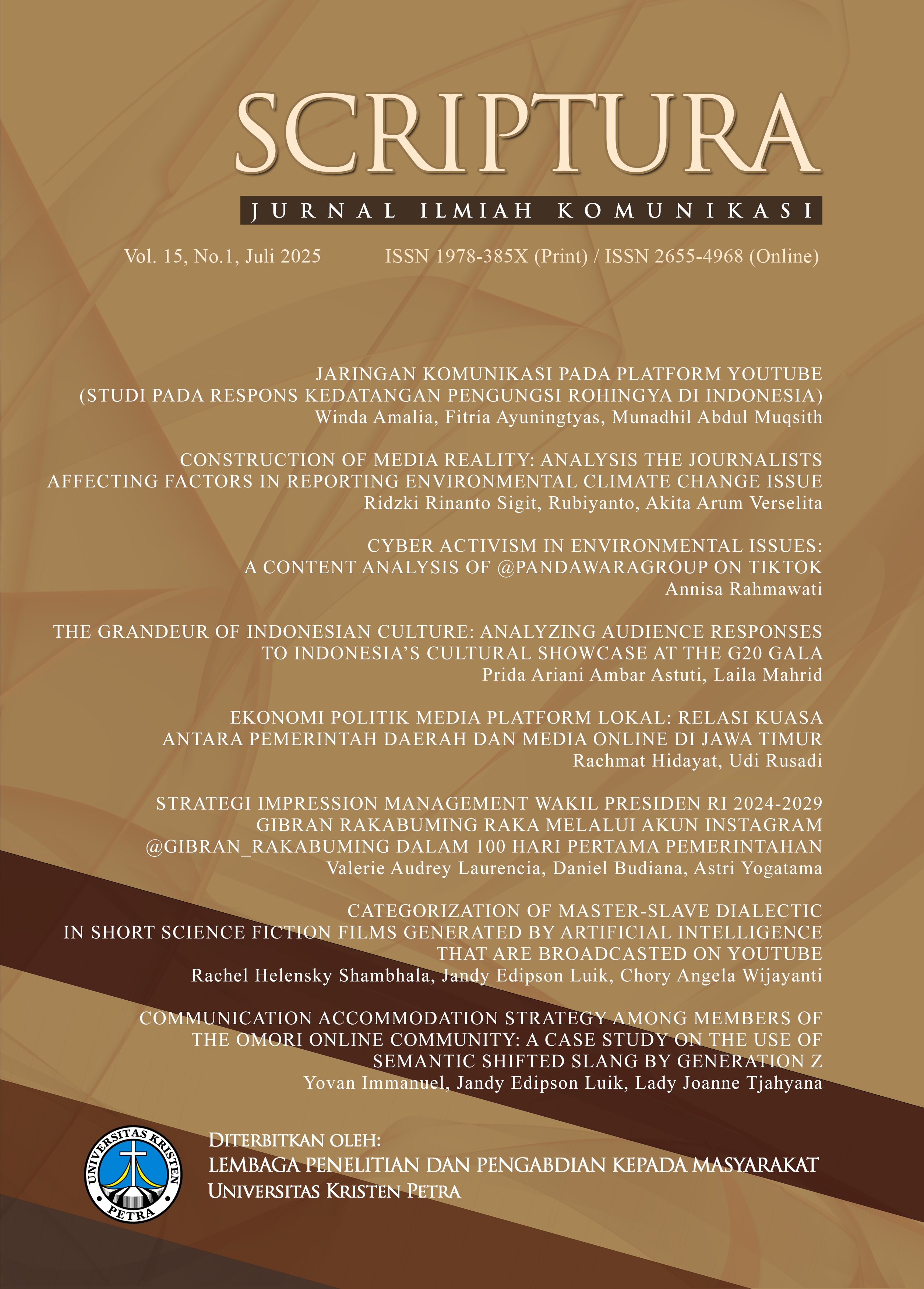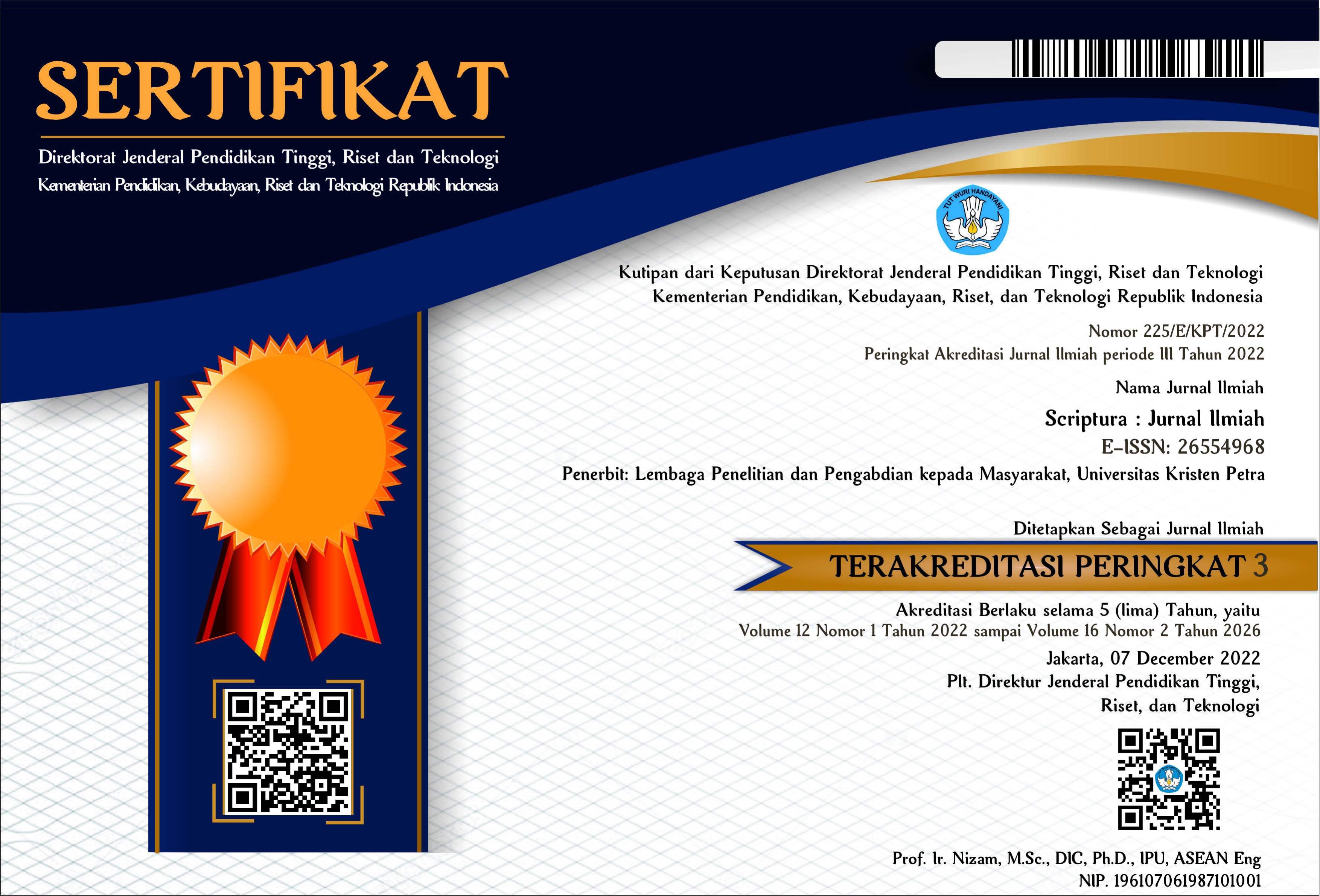Communication Accommodation Strategy Among Members of the OMORI Online Community: A Case Study on the Use of Semantic Shifted Slang by Generation Z
DOI:
https://doi.org/10.9744/scriptura.15.1.95-106Keywords:
communication accommodation, OMORI virtual community, semantic-shifted slang, group communication, group membershipAbstract
Communication accommodation is a process that is undergone by all new members of a community. The rapid growth of online communities among Generation Z has fostered the emergence of unique linguistic practices, including semantic-shifted slang, which can present challenges for new members to adapt and integrate. This study examines how communication accommodation strategies are employed by members of the OMORI virtual community on Discord, focusing on the use of semantic-shifted slang as a tool for group adaptation. The OMORI community serves as a platform for the players to meet and discuss with other OMORI players. This study attempts to research the OMORI virtual community in Discord, where the group members also often have other smaller groups which help them in their communication accommodation process. Employing a case study qualitative approach through semi-structured interviews, findings reveal that convergence—through observation, imitation, and gradual adoption of slang—is the dominant strategy, with small groups serving as safe spaces for experimentation and learning. Divergence also occurs when slang conflicts with personal identity or self-image. This research contributes to the field of communication studies by deepening the understanding of Communication Accommodation Theory in virtual, interest-based communities, highlighting how slang functions as both a symbolic and practical tool for fostering cohesion, negotiating identity, and strengthening group membership in online spaces.
References
Agostini, S., & Mechant, P. (2019). Towards a Definition of Virtual Community. Signo y Pensamiento, 38(74). https://doi.org/10.11144/javeriana.syp38-74.tdvc.
Alawiyah, S., Zuriyati, & Lustiyantie, N. (2021). Slang Language as Representatives of Social Culture Identity in Film Step Up 2 The Streets. IJLECR - INTERNATIONAL JOURNAL OF LANGUAGE EDUCATION AND CULTURE REVIEW, 7(2), 204–213. https://doi.org/10.21009/ijlecr.072.20
Arianto & Bahfiarti, T. (2020). Computer Mediated Communication Dalam Perencanaan Pembangunan Daerah Provinsi Sulawesi Barat. Avant Garde, 8(1), 60. https://doi.org/10.36080/ag.v8i1.973.
Ayoko, O.B., Härtel, C.E.J., and Callan, V.J. (2002). Resolving The Puzzle Of Productive And Destructive Conflict In Culturally Heterogeneous Workgroups: A Communication Accommodation Theory Approach. International Journal of Conflict Management, 13(2), 165-195. https://doi.org/10.1108/eb022873.
Bhatt, A., Goldberg, A., & Srivastava, S. (2022). A Language-Based Method for Assessing Symbolic Boundary Maintenance between Social Groups. Sociological Methods & Research, 51, 1681 - 1720. https://doi.org/10.1177/00491241221099555.
Chen, P., & Ha, L. (2023). Gen Z’s Social Media Use and Global Communication. Online Media and Global Communication, 2(3), 301–303. https://doi.org/10.1515/omgc-2023-2006.
Frey, L. R. (1999). The Handbook of Group Communication Theory & Research (D. S. Gouran & M. S. Poole, Eds.). Sage Publications.
Giles, H., & Ogay, T. (2007). Communication Accommodation Theory. In B. B. Whaley & W. Samter (Eds.), Explaining communication: Contemporary theories and exemplars (pp. 293–310). Lawrence Erlbaum Associates Publishers.
Grandez, M. B., Ablero, M. C., Lasala, R. M., Gomez, Ma. T., & Bonganciso, R. T. (2023). Forda Ferson: The morphological structure of generation Z slang in social media. Journal of English as A Foreign Language Teaching and Research, 3(2), 14 30. https://doi.org/10.31098/jefltr.v3i2.1847
Greene, J. O. (Ed.). (1997). Message Production: Advances in Communication Theory. Lawrence Erlbaum Associates Publishers.
Hoffman, Zhang, Y. B., & Bennett, W. (2022). Explaining Communication Adjustment: Communication Accommodation Theory and Its Utility in Intercultural Communication. Journal of Intercultural Communication & Interactions Research, 2(1). https://doi.org/10.1093/acrefore/9780190228613.013.484.
Herdiansyah, H. (2015). Metodologi Penelitian Kualitatif Untuk Ilmu Psikologi. Jakarta: Salemba Humanika.
Hutabarat, D. N., Lubis, R. A., & Harefa, Y. (2020). An Analysis of Slang Words in Star Wars Jedi Academy: The Force Oversleep. Nusa Jurnal Ilmu Bahasa dan Sastra.
Keywords Studios. (2024). How Moderation Improves Community Engagement in Discord. Keywords Studios Plc. https://www.keywordsstudios.com/en/about-us/newsevents/news/how-moderation-improves-community-engagement-in-discord/.
Kothari, C. R. (2004). Research methodology methods & techniques. New Age International (P) Ltd., Publishers.
Manurung, J., Napitupulu, M., & Simangunsong, H. (2022). Exploring the Impact of Slang Usage Among Students on WhatsApp: A Digital Linguistic Analysis. Jurnal Ilmu Pendidikan dan Humaniora. https://doi.org/10.35335/jiph.v11i2.21.
Moleong, L. J. (2021). Metode Penelitian Kualitatif: Edisi Revisi. PT Remaja Rosda Karya.
Musfirah, U., Larasakti, H., Putri Aurora Nst, H., & Tazkiyah, N. (2024). Analysis of Z Generation Group Communication Dynamics in the Digital Era. Proceedings of International Conference on Social Science, Political Science, and Humanities (ICoSPOLHUM), 4, 00016. https://doi.org/10.29103/icospolhum.v4i.389.
Mutonga, L., & Mukaro, L. (2021). The role of language in prophetic movements’ advertisements in Harare, Zimbabwe. Miṣriqiyā, 1(1), 20–45. https://doi.org/10.21608/misj.2020.42642.1002
Olaniyan, O. R., & Oluremi, T. A. (2024). (Re)constructing Nigerianisms through sarcasm and irony in selected Nigerian slangs and mannerisms. Atras Journal. https://doi.org/10.31235/osf.io/tu9er
Parkinson, B. (2020). Intragroup emotion convergence: Beyond contagion and social appraisal. Current Opinion in Psychology, 35, 1–5. https://doi.org/10.1016/j.copsyc.2020.03.004.
Pratiwi, A., Nurlatif, R., & Madanacaragni, M. (2021). Akomodasi Komunikasi Etnis Tionghoa dan Sunda di Surya Kencana Bogor. Jurnal Pustaka Komunikasi, 4. https://doi.org/10.32509/PUSTAKOM.V4I1.1349.
Putrawan, I. M. Y., Sudipa, I. N., & Sukarini, N. W. (2020). Slang Words Used in the Movie Script Harold and Kumar Go to White Castle. Humanis, 24(2), 150-158.
Radke, H. (2021). Language contact and mixed-mode communication: On ingroup construction through multilingualism among the German-Namibian diaspora. German(Ic) in Language Contact: Grammatical and Sociolinguistic Dynamics, 6, 127–158. https://doi.org/10.5281/zenodo.4954483.
Shaw, P. (2008). Spelling, Accent and Identity in Computer-Mediated Communication. English Today 24(2). 42–49.
Soliz, J. & Giles, H. (2012). Communication Accommodation Theory: A Contextual and Meta Analytical Review. Conference paper, International Communication Association, Annual Conference 2012, Phoenix, AZ, 235–258.
Silalahi, U. (2012). Metode Penelitian Sosial. Jakarta: PT Refika Aditama.
Sugiyono. (2013). Metode Penelitian Bisnis. Bandung: Alfabeta.
Syafrudin, & Hamidah. (2009). Kebidanan Komunitas. EGC Penerbit Buku Kedokteran.
Tarihoran, N., Fachriyah, E., Tressyalina, & Sumirat, I. R. (2022). The Impact of Social Media on the Use of Code Mixing by Generation Z. International Journal of Interactive Mobile Technologies (iJIM), 16(07), 54–69. https://doi.org/10.3991/ijim.v16i07.27659.
Turner, J. C., M. A. Hogg, P. J. Oakes, S. D. Reicher, M. S. Wetherell. (1987). Rediscovering the Social Group: A Self-Categorization Theory. Oxford: Blackwell.
Widawski, M. (2013). Semantic change in African American slang. Stap, 48(1), 29 44. https://doi.org/10.2478/stap-2013-0002
Wolf, S., Heerdink, M., & Van Kleef, G. (2023). A Motivational Account of Convergence in Emotion Expressions Within Groups: The Emotional Conformity Framework. Emotion Review, 15 (pp. 363 - 379). https://doi.org/10.1177/17540739231182241.
Wood, Clare, Kemp, N., Plester, B. (2013). Text Messaging and Literacy: The Evidence. London: Routledge.
Downloads
Published
How to Cite
Issue
Section
License
Copyright (c) 2025 Yovan Immanuel, Jandy Edipson Luik, Lady Joanne Tjahyana

This work is licensed under a Creative Commons Attribution 4.0 International License.
Authors who publish in the SCRIPTURA Jurnal Ilmiah agree to the following terms:
Authors retain unrestricted copyright and full publishing rights. The authors grant the Publisher the right of first publication, with the work simultaneously licensed under the terms and conditions of the Creative Commons Attribution License (CC BY) that allows for unlimited use, distribution, and content reproduction on all media as long as the original author and source are properly acknowledged and cited.


















